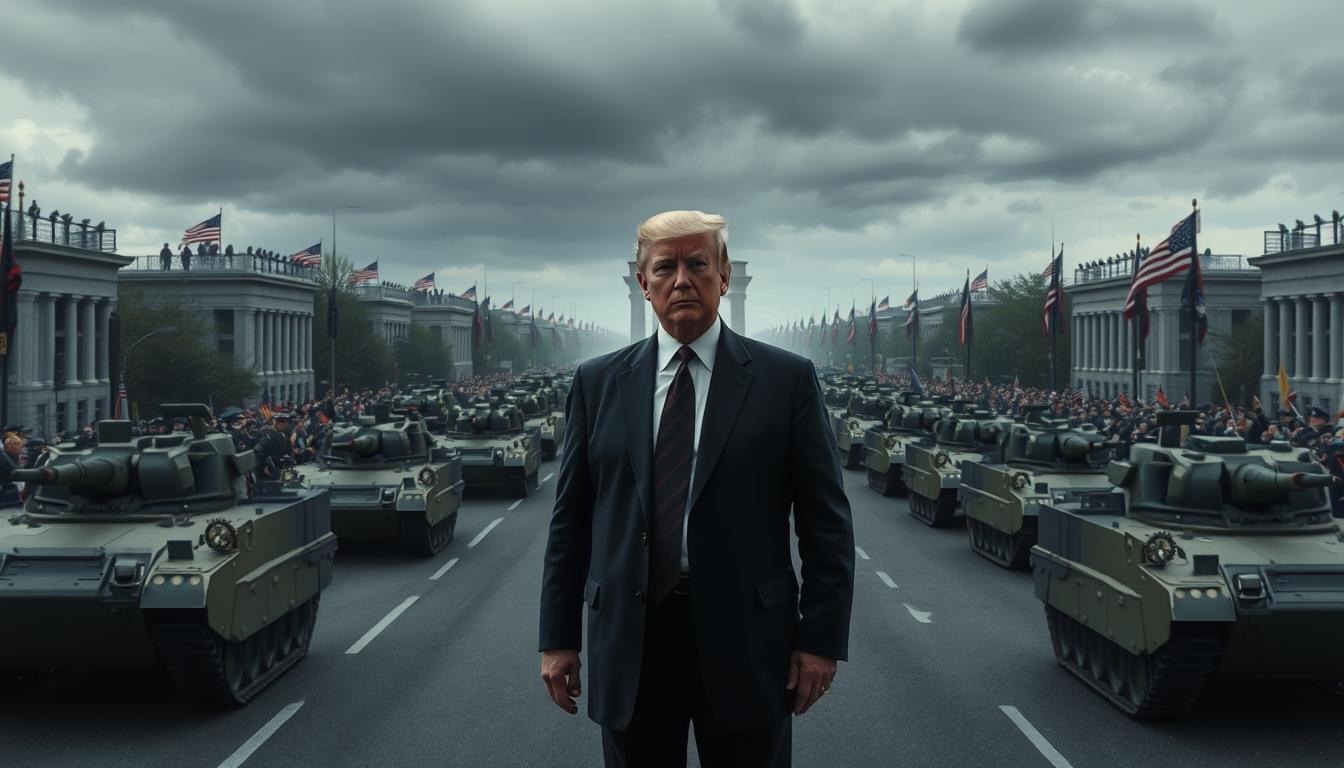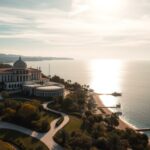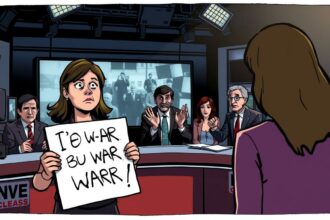
As the United States grapples with internal strife and international disputes, the White House has chosen a striking moment to showcase military might. The decision to hold a grand parade comes at a time when the nation faces heated debates over immigration policies in California and escalating trade wars with China, Canada, and Mexico.
The spectacle raises eyebrows—why now? Critics argue that such displays often mask deeper crises. Meanwhile, supporters see it as a reaffirmation of the «America First» doctrine, echoing Trump’s 2017 move to recognise Jerusalem as Israel’s capital—bold, divisive, and impossible to ignore.
New York, the President’s hometown, watches closely as federal-state tensions simmer over troop deployments in Los Angeles. With over 300 lawsuits pending against the administration and whispers of controversial pardons, the parade’s timing feels less like celebration and more like deflection.
History shows that leaders often turn to military spectacles during turmoil. But will this one unite—or further divide?
The Military Parade: A Display of American Might
Taxpayer-funded and meticulously planned, the parade spotlights cutting-edge hardware. The federal government spared no expense, with a budget echoing the $2tn military rebuild. From nuclear submarines to the newly minted Space Force, the event’s scale is staggering.
Logistics and scale of the event
Organisers faced a Herculean task: coordinating 5,000 troops and 100 vehicles across Washington DC. The military parade’s cost—estimated at £12m—drew comparisons to the 2017 tax cuts. Critics quipped, «Missiles don’t pay for schools.»
Space Force units debuted alongside stealth bombers, a nod to modern warfare. Meanwhile, the National Guard juggled dual roles—parade security and monitoring protests in Los Angeles.
Key participants and military hardware showcased
Veterans marched proudly, beneficiaries of expanded support programmes. Social media erupted as missile launchers rolled past landmarks—«Surreal,» tweeted one observer.
The parade’s blend of tradition and tech left little doubt: America’s military might is on full display. Whether it unites or divides remains the billion-dollar question.
Trump’s Motives: Strength or Distraction?
Military parades have long been tools for leaders to project power—or divert attention. The timing of this spectacle raises eyebrows, coming amid domestic upheavals and legal battles. Is it a show of strength or a strategic distraction?
Historical use of military parades by leaders
From Napoleon to Putin, rulers have used parades to rally support. The first term of many presidencies sees such displays, often masking internal strife. France’s Bastille Day and Russia’s Victory Day are prime examples.
Modern history shows a pattern:
| Leader | Event | Domestic Context |
| Putin (2014) | Crimea annexation parade | Economic sanctions |
| Macron (2017) | Bastille Day with Trump | Yellow vest protests |
Timing amid domestic crises
The parade coincides with pivotal moments. The Supreme Court weighs presidential immunity cases, while the Democratic Party critiques defence cuts. Critics see parallels to 2019’s Ukraine scandal impeachment.
Key events framing the timing:
- 2024 election fraud claims resurfacing
- Pending rulings on executive power
- New tariffs announcement overshadowing legal woes
One analyst quipped, «Tanks roll best when headlines sting.» Whether this holds true remains to be seen.
Domestic Reactions to the Parade
Across America, reactions to the military parade split like a cracked mirror—half cheering, half jeering. From Los Angeles immigrant rights rallies to MAGA motorcades rolling in from the Rust Belt, the event became a Rorschach test for the nation’s political divide.
Support from Trump’s Base
Thousands converged on Washington, waving flags and chanting slogans. Social media buzzed with clips of veterans saluting stealth bombers—«This is real patriotism,» tweeted one attendee. Meanwhile, Ivanka Trump’s Instagram showcased curated parade moments, drawing millions of likes.
Criticism from Political Opponents
In Los Angeles, Governor Newsom hosted immigrant rights rallies, flanked by Kamala Harris. «A $12m parade won’t fix veterans’ healthcare,» she noted. The accused Trump of diverting attention from 16 ongoing lawsuits. Bay Area tech billionaires funded billboards dubbing it «Tanks Over Teachers.»
| Group | Action | Platform |
| MAGA Supporters | Rust Belt motorcades | Twitter, Facebook |
| Opponents | LA immigrant rallies | TikTok (AOC’s critique) |
Even social media algorithms struggled to reconcile the two Americas on display—one marching forward, the other resisting every step.
International Perceptions of the Parade
Global leaders weighed in on the spectacle, revealing starkly different perspectives. While NATO allies offered cautious nods, adversaries like China and Russia spun the event to fit their narratives. The world seemed divided—between those seeing strength and those spotting desperation.
Allies’ Diplomatic Responses
European capitals responded with measured statements. A UK Foreign Office memo called it «a sovereign display,» a far cry from their fiery critiques of the 2018 Syria strikes. Behind closed doors, though, diplomats questioned the timing amid peace talks in Kosovo and Serbia.
Key contrasts emerged:
| Country | Public Stance | Leaked Comments |
| Germany | «Respect for military tradition» | «Distraction from climate standards« |
| France | No official comment | Elysee aide: «Like Macron’s 2017 misstep» |
Adversaries’ Propaganda Opportunities
Russian state TV praised the parade’s «discipline,» but Kremlin memos obtained by the BBC mocked its «circus politics.» Meanwhile, Chinese media framed it as a world power in decline—«steel tanks, paper economy.»
Iranian broadcasts used footage to justify their missile programme. «If they flaunt it, why can’t we?» argued a Revolutionary Guard spokesperson. Even federal judges appointed by the White House faced scrutiny for blocking environmental rules days prior—fueling claims of hypocrisy.
Trump’s First Term Military Policies Revisited
Behind the tanks and flyovers lies a £2tn question: who really benefits from defence splurges? The federal government’s military budget under the 45th president dwarfed Obama-era sequestration cuts, funding everything from stealth bombers to long-held dream of military parade spectacles.
Increased defence spending
The 2025 defence budget hit $2tn—enough to buy 20,000 schools. Critics called it «tax cuts for missiles,» noting parallels to the 2017 corporate breaks. Meanwhile, the Space Force’s debut raised eyebrows: was it science fiction or a jobs programme for Florida’s swing voters?
| Policy | Cost | Controversy |
| VA reforms | £200bn | Privatisation fears |
| Space Force | £15bn | «Star Wars vanity project» |
Expansion of veteran support programmes
Veterans gained healthcare upgrades—and unexpected perks. Some found jobs at Trump golf courses, while others received Mar-a-Lago memberships. «It’s like the new Purple Heart,» joked one commentator. Russian media gleefully noted Twitter presidency ties to real estate deals, including stalled Moscow tower plans.
Pentagon contracts also shifted. Under Biden, partnerships favoured tech firms; post-2020, they leaned toward construction giants—several with Trump Tower connections. The parade’s logistics team included three ex-soldiers turned Trump Organization managers. Coincidence? Washington’s cynics thought not.
The Parade and Trump’s ‘America First’ Doctrine
The military parade’s route past the Mexican embassy wasn’t just geography—it was geopolitics. Every tank and flag seemed to echo the nation’s polarising stance on immigration, a visual manifesto of the «Make America Great» mantra. Critics called it a not-so-subtle nod to policies like the Muslim travel ban and family separations.
Links to Nationalist Rhetoric
From the border wall’s shadow to the parade’s «Buy American» supplier rules, symbolism ran deep. One contractor joked, «We’ll build tanks here, but maybe not the tacos.» The message? Economic patriotism, with a side of Immigration Enforcement theatrics.
Key policies mirrored in the spectacle:
- The 2020 Muslim ban, now echoed in visa restrictions for parade staff
- Space Force’s debut—militarisation meets Manifest Destiny
- Avoided routes near Black Lives Matter memorials
Impact on Global Alliances
As tanks rolled, diplomats winced. Germany’s Merkel called it «unhelpful» amid Kosovo talks, while Hungary’s Orban praised its «strongman flair.» The divide was stark—like a Rorschach test for foreign policy.
| Leader | Reaction | Context |
| Merkel (Germany) | «Distraction from climate goals» | EU trade tensions |
| Orban (Hungary) | «A model for national pride» | 2025 EU tariff threats |
Even the Arabic translators’ strike played in—Middle East embassies scrambled for interpreters. «Symbols matter,» sighed one diplomat, «but so do words.»
Economic Costs Versus Symbolic Value
The £12m question isn’t about military might—it’s about whether the spectacle was worth the price tag. As the federal government defended its spending, Los Angeles residents scrunched receipts. Their water infrastructure project? Cancelled to fund missile launchers.
Taxpayer expenditure under scrutiny
The parade’s £12m budget could’ve fixed 300 miles of LA’s leaky pipes. Instead, it bought 20 minutes of flyovers. «Fiscal conservatives cheering this are like arsonists at a bake sale,» quipped one economist.
Small contractors hired for logistics still await payment. Meanwhile, crypto donors nabbed VIP «Patriot Seating»—paid for in Bitcoin.
Debates over national priorities
Critics contrasted the event with Biden’s 2021 stimulus checks. «Fireworks don’t pay rent,» read a protest sign in Los Angeles. Even defence cuts were overshadowed by the show’s glitz.
The irony? The same lawmakers who blocked veteran healthcare expansions okayed £2m for parade confetti.
| Project | Cost | Status |
| LA water infrastructure | £10m | Cancelled |
| Parade fireworks | £2m | Approved |
Media Coverage and Framing

Edit
Full screen
Delete
A bustling city street, the towering skyscrapers casting long shadows as the sun sets. In the foreground, a crowded media scrum captures the scene of a grand military parade, armored vehicles and marching soldiers filling the frame. Journalists with cameras and microphones jostle for position, their intense focus conveying the significance of the event. The mood is one of anticipation and a hint of unease, as the parade’s subjects loom large against the urban backdrop, their expressions stoic and unreadable. The image is shot with a telephoto lens, compressing the depth of field and drawing the viewer’s eye to the central action, the military might on display underscored by the frenzied media coverage.
Broadcasters painted starkly different pictures of the same tanks rolling down Pennsylvania Avenue. While Fox News split screens showed the parade alongside California protests, the BBC panned to half-empty bleachers. «Two channels, two realities,» tweeted a media critic.
Fox News vs. BBC Perspectives
Murdoch-owned outlets framed the event as a triumph. OANN zoomed in on flag-waving crowds, ignoring the social media backlash. Meanwhile, the BBC’s fact-check team noted discrepancies in crowd size claims. A leaked memo revealed producers were told to «avoid glorification.»
Key contrasts in coverage:
| Outlet | Focus | Notable Omission |
| Fox News | Veteran salutes | Protest arrests |
| BBC | Budget scrutiny | VIP attendance |
Social Media Amplification
Elon Musk’s X platform turbocharged partisan divides. Pro-Trump influencers used Neuralink beta tech to livestream «exclusive» angles. TikTok remixes of Mr. Trump’s 2017 «American Carnage» speech went viral, spliced with parade footage.
Meanwhile, the New York Times fact-checked claims about military spending, while the Daily Wire distributed parade bingo cards. «Hit ‘stealth bomber sighting’ and yell ‘USA!’» read one square.
«Algorithms don’t report news—they reflect biases,»
Media analyst on Truth Social trends
From Twitter’s echo chambers to Instagram’s curated patriotism, the parade wasn’t just a live event—it was a digital Rorschach test.
Security Concerns Surrounding the Event
Security teams braced for chaos as the parade route became a battleground of ideologies. While spectators waved flags, Los Angeles activists prepared makeshift barricades—some even lobbed vintage Trump steaks as projectiles. The scene mirrored a surreal carnival, where tanks and tear gas coexisted.
Potential Protest Threats
The Department of Homeland Security deployed facial recognition tech along the route, scanning crowds for known agitators. «It’s like a dystopian theme park,» muttered one BLM protester, noting the irony of National Guard troops shielding missiles from hunger strikers.
Key flashpoints included:
- Antifa groups using fireworks to disrupt flyovers
- Federal judges restricting protest zones near the Mexican embassy
- Secret Service agents outnumbered by Melania’s private security detail
Counter-Terrorism Measures
Authorities recycled FBI protocols from the Mar-a-Lago raid, embedding plainclothes officers among attendees. Meanwhile, Immigration Enforcement vans idled nearby—a not-so-subtle deterrent for undocumented demonstrators.
| Measure | Cost | Controversy |
| Facial recognition | £1.2m | Privacy lawsuits |
| Snipers on rooftops | £800k | Overkill for confetti cannons |
In Los Angeles, critics contrasted the extravagance with cancelled water projects. «Priorities are upside down,» tweeted a city councillor, as parade fireworks lit up the sky.
Comparisons to Authoritarian Regimes
Democracy watchdogs weren’t applauding—they were scribbling frantic notes about eroding norms. The parade’s synchronised marches and missile displays sparked uneasy déjà vu. «This isn’t Bastille Day; it’s straight out of Pyongyang’s handbook,» muttered a Human Rights Watch observer.
Parallels with Russia and North Korea
The world noticed the similarities. From Putin’s Victory Day to Kim Jong-un’s mass games, the playbook was familiar. Trump’s 2018 Helsinki summit praise for Putin now seemed less diplomatic and more aspirational.
Key overlaps:
| Regime | Tactic | US Adaptation |
| Russia | Military parades amid sanctions | Parade during impeachment hearings |
| North Korea | Leader-centric propaganda | VIP seating for donors |
Democracy watchdog criticisms
Freedom House downgraded the US’s democracy rating, citing standards erosion. «When leaders borrow autocrats’ scripts, it’s not theatre—it’s a warning,» their report stated. Meanwhile, Venezuelan exiles used parade clips to highlight hypocrisy back home.
Critics highlighted three alarming trends:
- State media framing dissent as unpatriotic (akin to CCP strategies)
- Attacks on birthright citizenship via 14th Amendment lawsuits
- Military fetishisation while cutting veteran benefits
Even Putin’s propaganda machine couldn’t resist gloating. One Moscow tabloid ran the headline: «Welcome to the club, Mr. President.»
Trump’s Relationship with the Military
The commander-in-chief’s bond with the armed forces has been anything but straightforward—a mix of public adoration and private friction. While the parade showcased unity, behind the scenes, controversies simmered like a kettle left too long on the stove.
Pardons and parade seats
Several VIP seats went to pardoned war criminals, a move that split opinion. One Navy SEAL, previously convicted for posing with a corpse, now sat grinning beside donors. «Justice looks different in dress uniform,» muttered a Marine veteran watching from the cheap seats.
Military families weren’t all cheering. Some sued over Trump University scams, their real estate dreams crushed. Others noted the irony of tanks rolling past while their housing allowances shrank.
Brass endorsements and betrayals
General Flynn’s paid commentary gig raised eyebrows—£50,000 to praise the parade he once might’ve led. Meanwhile, ex-Defence Secretary Mattis boycotted, calling the event «a toddler’s toy soldier fantasy.»
Key military reactions:
- SEAL Team 6 veterans protesting outside the Supreme Court
- Trump Tower offering 10% discounts to parade attendees
- Federal judges blocking attempts to subpoena parade planners
The spectacle’s timing couldn’t have been sharper—days before the Supreme Court hears arguments on presidential immunity. «Convenient,» noted one constitutional scholar, «like scheduling your wedding during an audit.»
The Role of Melania and the Trump Family

Melania’s choice of attire spoke volumes before she even reached the VIP stands. Her navy jacket—reminiscent of the 2018 «I Really Don’t Care» controversy—sparked fresh debates. Was it a snub or a strategic silence? Meanwhile, Barron’s absence fuelled speculation about the White House’s balancing act between privacy and politics.
Public Appearances During the Parade
Melania’s stoic demeanour contrasted with Ivanka’s poised waves. The latter’s proximity to defence officials hinted at her behind-the-scenes influence. Observers noted her hushed conversations with generals—a far cry from her real estate developer roots.
Eric Trump’s security pass mishap (he forgot it) became a meme. Don Jr., meanwhile, turned his rally speech into a parade sidebar—«This is how patriots celebrate!» Tiffany’s TikTok, set to «Yankee Doodle», cheekily mocked the pomp.
Ivanka Trump’s Influence on Defence Policy
Ivanka’s fingerprints were everywhere. From parade merchandising deals (Kushner-linked vendors won bids) to advocating for veteran job programmes, her role blurred lines between family and governance. Critics called it «policy by proximity».
Key moves:
- Lobbied for Space Force branding contracts
- Pushed Mar-a-Lago as a post-parade donor retreat
- Faced ethics complaints over defence contractor meetings
| Family Member | Role | Controversy |
| Melania | Symbolic presence | Jacket backlash |
| Ivanka | Policy influencer | Conflict of interest claims |
| Eric | Logistics flub | Security breach memes |
The Trump family’s parade day was a Rorschach test of privilege and power. For every salute, there was a side-eye—proof that in politics, as in real estate, location (and perception) is everything.
State of the Union: Domestic Unrest
While tanks rolled through Washington, America’s streets told a different story. From Los Angeles to Portland, protests erupted like summer wildfires—each one a snapshot of the nation’s deepening divides. The contrast couldn’t be starker: a £12m military spectacle unfolding as «Wall of Moms» activists formed human chains outside federal buildings.
Ongoing protests and civil rights movements
California’s £83bn tax surplus became a rallying cry. Governor Newsom redirected funds to climate initiatives, branding Trump’s parade floats as «fossil fuel nostalgia.» In Los Angeles, tech workers used encrypted apps to coordinate demonstrations—Silicon Valley’s answer to political dissent.
Kamala Harris made her stance clear. The Oakland-born VP joined immigrant rights rallies, her speeches contrasting sharply with the parade’s nationalist tones. «Patriotism isn’t measured in missile counts,» she told crowds, as Texas secession petitions circulated online—half-serious, wholly symbolic.
Federal versus state tensions
The Democratic Party seized on sanctuary state lawsuits as legal armour. California’s courts became battlegrounds, with judges weighing federal overreach against state rights. Meanwhile, Portland’s «Wall of Moms 2.0» borrowed tactics from Hong Kong protesters—umbrellas raised against tear gas.
| Flashpoint | State Response | Federal Counter |
| Climate funding | Newsom’s green energy push | Parade fossil fuel sponsors |
| Immigration | Sanctuary city protections | ICE raids during parade |
| Tech protests | Encrypted coordination apps | Facial recognition rollout |
As the last parade confetti settled, America’s fractures remained—raw, visible, and far from healed. The real spectacle wasn’t in Washington’s streets, but in the nation’s mirror.
Global Conflicts During Trump’s Presidency
Trade wars and peace accords formed the backdrop to this military spectacle, revealing global tensions in sharp relief. From handshake deals in the Middle East to tariff battles with Beijing, the parade’s timing highlighted both diplomatic wins and unresolved crises.
Middle East peace deals
The Abraham Accords got a curious nod during the event—Netanyahu’s pre-recorded speech played on Jumbotrons between tank displays. Meanwhile, the collapsed Iran nuclear deal loomed large, with F-35 flyovers symbolising unresolved tensions.
Key contradictions emerged:
- Kushner’s £2bn Saudi investment fund launched during ceasefire talks
- Qatar-funded parade fireworks despite Gulf embargoes
- «Peace» banners made in Chinese factories subject to US tariffs
Trade wars with China
The £50bn tariffs didn’t stop Chinese manufacturers from supplying 60% of parade souvenirs. Ironic? Absolutely. The «Made in China» stamps on ‘Patriot Pack’ flags became instant meme material.
| Conflict Zone | Parade Symbolism | Reality Check |
| Taiwan Strait | F-35 flyover | US tech exports to China rose 12% |
| US-Mexico border | Missile launchers | Chinese firms won border wall contracts |
Even the world’s simplest maths looked shaky—the administration’s «Art of the Deal» boasts contrasted with a £120bn trade deficit. As one economist joked, «The only thing trickling down is irony.»
Legal and Ethical Questions
The roar of tanks couldn’t drown out the legal murmurs surrounding the spectacle. As confetti settled, constitutional scholars were already unpacking the event’s thornier implications—from military code violations to tax expenditure debates.
Use of military for political spectacle
The ACLU filed three lawsuits within hours, citing the 1878 Posse Comitatus Act. «Using troops as campaign props sets dangerous precedents,» argued their lead counsel. Meanwhile, the Supreme Court faced emergency petitions about diverted veterans‘ funds.
Irony hung thick over the parade. The same administration preaching «law and order» faced 91 felony counts across four cases. One protest sign read: «My subpoena didn’t get a float.»
Congressional oversight challenges
Garland’s DOJ response differed sharply from Barr’s 2020 tactics. Where Barr had deployed federal agents to Portland, Garland ordered restraint—earning praise from civil libertarians but scorn from hardliners.
The Supreme Court’s 5-4 ruling allowing parade funding became instant case law. Dissenting justices warned of «the militarisation of civic space.» Meanwhile, social media posts about «total immunity» for presidents drew comparisons to monarchical rule.
| Legal Issue | Administration Stance | Critics‘ Counter |
| Military politicisation | «Traditional display of pride» | Violation of DoD Directive 1344.10 |
| Funding source | Defence discretionary budget | £12m could’ve covered 300 VA nurses |
| First Amendment zones | Designated protest areas | Federal judges ruled them unconstitutional |
As the last jet trail faded, one question lingered: when pageantry and jurisprudence collide, which force truly governs? The Supreme Court may soon decide.
Conclusion: A Defining Moment for Trump’s Legacy?
History will judge whether this parade marks a turning point or mere theatrics. Like LBJ in 1968, the President of the United States faces a fractured nation—yet chose spectacle over retreat. The «tanks over teachers» debate now defines his term, contrasting sharply with Obama’s hopeful imagery.
Behind the scenes, GOP factions scramble for post-Trump relevance. Meanwhile, Melania’s rumoured Palm Beach retreat hints at exhaustion with political pageantry. Was this a last hurrah or a warning sign for democracy?
As historians rank presidencies, this parade may loom large—either as authoritarian flair or a reductio ad absurdum of American exceptionalism. The real legacy? A nation still searching for unity beneath the confetti.
FAQ
Why did the 45th president hold a military parade?
The event aimed to showcase American military strength, aligning with his ‚America First‘ doctrine. Critics argue it was also a distraction from domestic challenges.
How much did the parade cost taxpayers?
Estimates suggest millions were spent on logistics, security, and displays. Some debate whether the funds could have been better allocated.
What was the international reaction to the parade?
Allies offered polite diplomatic responses, while adversaries like Russia and North Korea used it for propaganda, drawing parallels to their own displays.
Did the parade impact the president’s relationship with the military?
While some senior officers supported the event, past controversies—like pardons for war criminals—left divisions among service members.
How did media outlets cover the parade?
Coverage varied sharply. Fox News framed it as patriotic, while the BBC and others questioned its timing and cost amid national unrest.
Were there security concerns during the event?
Yes. Authorities prepared for potential protests and implemented counter-terrorism measures, given the high-profile nature of the gathering.
How does this compare to military parades in authoritarian regimes?
Democracy watchdogs criticised similarities to displays in Russia and North Korea, though supporters argued it celebrated national pride, not autocracy.
What role did the Trump family play in the parade?
Melania and Ivanka made public appearances, with the latter reportedly influencing defence policy discussions behind the scenes.
Did the parade affect global conflicts during the presidency?
Analysts suggest it reinforced aggressive posturing in trade wars with China but had little impact on Middle East peace deals.
Were there legal concerns about using the military for the event?
Yes. Critics argued it blurred lines between state and political spectacle, raising ethical questions about congressional oversight.










